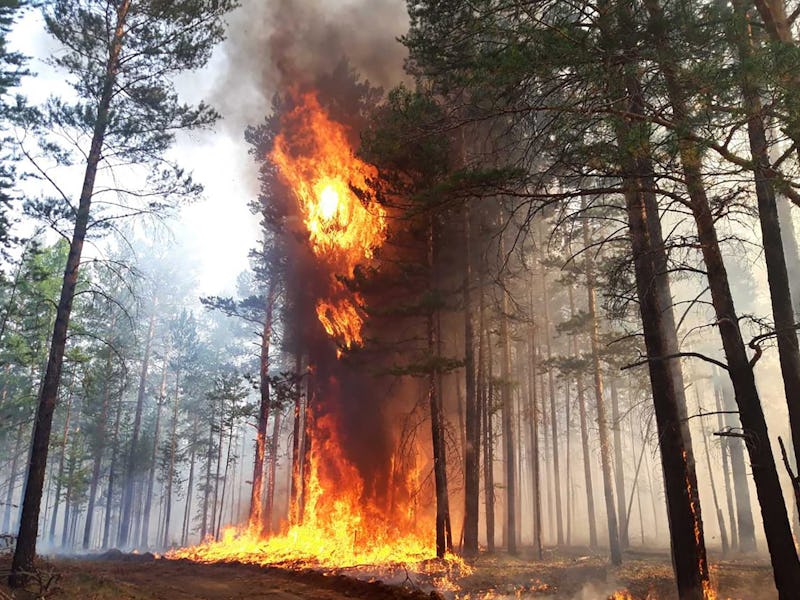Arctic wildfires: 5 reasons why “alarm bells should be ringing"
Record-setting fires may have dramatic effects on the climate.

Over the past few weeks, hundreds of wildfires have spread over the normally frozen Siberia. The fires are causing global alarm among scientists — and not just because of the land being burnt.
Russia's forest service reported last week that nearly 300 wildfires were burning in the northern region of the country. Contributing to the extreme blazes is bizarrely warm weather in the region — a condition that's been plaguing the area since January — and dry soil, reports Europe's Copernicus Climate Change Service.
Some areas of Siberia reached record-setting high temperatures this summer: The town of Verkhoyansk hit 100 degrees on June 20, a new all-time high.
Apart from causing immediate damage to forests, wildfires can spur other environmental dangers. These five factors help illustrate the entirety of the situation — and may point to the challenges the rest of the planet will face as the climate crisis continues:
- Carbon emissions
- Permafrost loss
- The suffering of wildlife
- Logging consequences
- Temperature unknowns
Carbon emissions toppling records — The carbon emissions released from the wildfires are setting new records for pollutants released in the areas facing the worst damage.
The Copernicus Atmosphere Monitoring Service measured that, in June, wildfires released 50 megatons of carbon dioxide into the atmosphere. That's the amount of carbon released annually by all of Sweden, the agency reports.
It's also more carbon than was released by June Arctic fires from 2010 to 2018. It's an all-time-high for June emissions since records began in 2003.
Earlier this summer, firefighters from the Yakut Branch of the Aerial Forest Protection Service orchestrated controlled burns to prevent more hazardous blazes in fire-prone areas.
Losing permafrost has long-term effects — According to the New York Times, scientists warn that these fires could lead to "more thawing of Arctic permafrost."
As its name suggests, permafrost is land that, under normal circumstances, is meant to remain permanently frozen in the Arctic. Because of its reliability in the past, infrastructure and even entire cities have been built on top of permafrost in the Arctic Circle. Recent years have seen crumbling buildings as the land beneath these structures begins to melt.
Earlier this year, melting permafrost unleashed a massive oil spill in Russia, releasing at least 20,000 tons of oil into the Ambarnaya and Daldykan rivers. In Svalbard, a Norwegian archipelago, a potentially vital "doomsday" seed bank is in danger of collapse because of thawing soil. The largest of the 1,700 seed vaults in the world, the Svalbard Seed Vault stores key plant seeds to be used in the event of a widespread crisis that devastates crops.
It's a crucial backup plan, now threatened by the kind of disaster it aims to mitigate.
Wildlife suffers from major fires — When large areas of land are singed, wildlife is forced to adapt quickly. Arctic wildfires have been shown to have major effects on the distribution of animals, reports the National Park Service.
Snowshoe hares, martens, and moose can all become displaced as patches of fires push the populations out of their usual habitats. Caribou tend to stay away from recently burned areas, which lack the lichen the animals forage on. It's not a situation that can be remedied quickly — lichens can take hundreds of years to recover.
And in areas where subsistence farming is a way of life — like Mongolia, where humans and reindeer live intertwined lives — the effects of fires on wildlife trickle into human territory.
Snowshoe hare populations can get pushed out by Arctic wildfires.
Curiously, some animals actually do better off post-fire: Voles and other small mammals, which eat the newly sprouted vegetation that comes with scorched land, create colonies on recently singed land.
Consequences of extreme logging — The widespread fires can be linked to another environmental conundrum in the Arctic, and elsewhere in the world: logging.
Logging may conjure images of oil palm plantations in the subtropics, but Russia frequently tops global charts when it comes to deforestation. In 2018, Russia lost 16.3 million acres of forest. By comparison, in the same year, the Amazon lost 9.1 million acres.
Clear-cutting forests removes carbon-storing trees. Forest fragments absorb 22 percent less carbon than fully functioning ones, according to research published earlier this year.
Fewer trees means more opportunity for carbon dioxide to collect in the atmosphere, and warm the planet. In an unfortunate back-and-forth, the conditions created by climate change also make it easier for forests to burn up.
“The climate is changing faster in the Arctic and we are getting drier and warmer conditions which are ideal conditions for wildfires to burn,” Mark Parrington, senior scientist at Copernicus Atmosphere Monitoring Service, said in a statement.
Record-setting temperatures leave unknowns — When the temperature reaches 100 degrees in a usually frozen area, it undoubtedly means that something is very off.
But because we haven't seen these record-setting numbers before, it also means that scientists aren't sure exactly what to expect next. Siberia is already known for its wildly fluctuating temperatures: It holds the world record for the greatest temperature range, from -90 degrees to 98 degrees Fahrenheit.
With the new wildfires, “alarm bells should be ringing,” climate scientist Jonathan Overpeck, dean of the University of Michigan's environmental school, told the AP.
Overpeck said that the long-term warmth in Siberia hasn't been seen over thousands of years. That makes it "another sign that the Arctic amplifies global warming even more than we thought.”